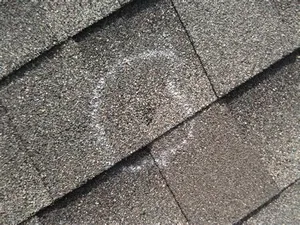Hail damage

Are you aware that during a hail storm more than just your vehicles are potentially vulnerable to damage and future repairs? When hail hits, it can damage the roof or covering of your home as well as other personal property. Although hailstorms can be destructive, the amount of damage can vary greatly. Following are some factors that affect the type and degree of damage that may be impacted by a hailstorm, as well as a guide on how to identify hail damage to different types of shingles and roofing materials.
- Wind – During a hailstorm, wind direction and wind speed can vary. Changes in wind conditions can affect the location and severity of hail impacts.
- Size and density – The size of the hailstones can affect the degree of damage, if any, to your property. A hailstone can be as small as a pea, or as large as a softball. Most hailstones do not have smooth edges, which can impact the type of damage they cause.
- Building materials – Building materials absorb hail impacts differently. For example, hail can cause dings in aluminum siding, gutters or asphalt shingles, whereas it can crack vinyl siding or wood shakes. Alternatively, softball-sized hailstones can be dense enough and strong enough to puncture a roof. Additionally, the age and condition of a roof could affect the degree of damage.
- Barriers – The position of neighboring structures and natural barriers, like tree cover, landscaping, fences or adjacent homes can reduce the ability of hail to cause damage.
What Does Hail Damage to Your Roof Look Like?
Shingles can react differently when struck by hail. As an example, hail damage to asphalt and composition shingles can look very different than hail damage to wood shingles. It is important to know the different effects of the damage to properly identify whether or not you have roof damage from hail.Asphalt and Composition Shingles Hail Damage

- Random damage with no discernable pattern.
- Hail hits that are black in color.
- Loss of granules, which may expose the roof felt.
- Asphalt and/or mat that appears shiny.
- Hail hits that are soft to the touch, like the bruise on an apple.

There are many other types of damage to shingles that can be mistaken for hail damage. For example, exposure to inclement weather and sunlight makes shingles brittle and gives them an aged appearance. This type of damage is normal wear and tear of shingles, which is sometimes misidentified as hail damage. Other types of normal wear and tear may include blistering, cracking, granule loss, flaking and algae. Manufacturing defects and mechanical imperfections in shingles can also be mistaken for hail damage.If you believe your home has sustained damage from hail, call your agent or insurance representative to discuss possible next steps.
SIGNS OF NORMAL WEAR AND TEAR


If you notice these signs, it’s not an urgent matter to get your roof fixed. However, these are indications that should be monitored before they develop into more serious problems.

- Fading Color
Over time, shingles lose some of their color due to exposure to severe weather, particularly direct sunlight. While faded shingles may appear weaker, they are more of a cosmetic concern than a structural defect. Still, keep a close eye on them because it is likely that they are approaching the end of their lifespan. - Lifted Shingles
High winds can lift the edges of asphalt shingles and potentially expose the underlying components to moisture, causing further damage. If you live in an area with frequent high winds, invest in reinforced shingles to prevent wind tear-offs. - Scratches
Sharp branches of overarching trees can scratch the protective granules off your roof. To avoid such occurrences, make it a routine to trim branches away from the surface of the roof.